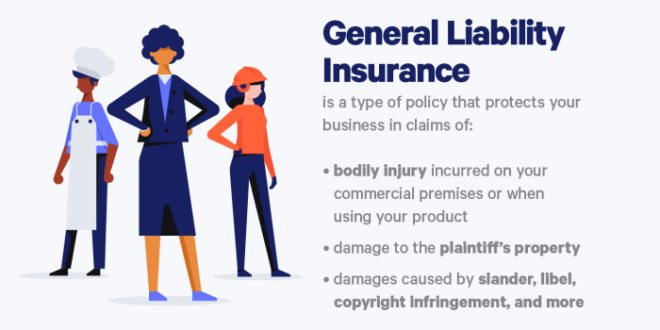General liability coverage for small businesses is a vital safeguard that shields them from financial risks associated with third-party claims of bodily injury, property damage, or personal injury. It provides peace of mind and ensures that businesses can operate with confidence, knowing that they have a safety net in place.
Understanding the types of coverage available, determining specific needs, navigating the claims process, and choosing the right insurance provider are all crucial aspects of securing effective general liability coverage. By carefully considering these factors, small businesses can tailor their policies to their unique requirements and protect their assets, reputation, and future.
Types of General Liability Coverage
General liability coverage is a crucial component of any small business insurance policy. It protects your business from financial liability resulting from bodily injury or property damage caused by your products, services, or operations. Several types of general liability coverage are available, each designed to address specific risks and scenarios.
Understanding the different types of general liability coverage and their benefits and limitations is essential for selecting the right policy for your business. Here’s an overview of the most common types of coverage:
Bodily Injury Liability
Bodily injury liability coverage protects your business if someone is injured or killed due to your business’s negligence. This coverage includes medical expenses, lost wages, and pain and suffering damages. Common scenarios covered by bodily injury liability include:
- A customer slips and falls on your business premises.
- A product you sell malfunctions and causes injury to a consumer.
- An employee injures a third party while performing their job duties.
Determining Coverage Needs: General Liability Coverage For Small Business

Tailoring general liability coverage to the unique needs of your small business is crucial for effective risk management. This involves assessing your specific exposures and determining appropriate coverage limits and deductibles.
Factors to consider when determining coverage needs include:
- Nature of Business Operations:The types of products or services offered, as well as the potential risks associated with your business activities.
- Size and Revenue:Larger businesses with higher revenue may require more extensive coverage.
- Industry and Location:Certain industries and geographic areas pose specific risks that may require specialized coverage.
- Past Claims History:A history of claims can indicate potential vulnerabilities and may impact coverage limits and premiums.
Coverage Limits
Coverage limits determine the maximum amount of coverage provided by your policy. Consider the following when setting coverage limits:
- Potential Liability:Estimate the potential financial impact of a lawsuit or claim against your business.
- Industry Standards:Review industry benchmarks to ensure your coverage limits are aligned with similar businesses.
- Risk Tolerance:Determine your willingness to retain a portion of the risk through higher deductibles.
Deductibles
A deductible is the amount you pay out-of-pocket before your insurance coverage kicks in. Consider the following when choosing a deductible:
- Financial Capacity:Choose a deductible that you can afford to pay without financial hardship.
- Premium Impact:Higher deductibles typically result in lower premiums.
- Risk Tolerance:A higher deductible means you retain more risk, while a lower deductible provides more immediate coverage.
Tailoring Coverage to Business Types
Different business types have unique coverage needs. Here are some examples:
- Retail Stores:Need coverage for customer injuries, product liability, and property damage.
- Service Providers:Require coverage for professional negligence, errors and omissions, and bodily injury.
- Construction Companies:Need coverage for property damage, workers’ compensation, and contractual liability.
By carefully assessing your coverage needs, you can tailor your general liability policy to provide comprehensive protection for your small business.
Claims Process and Coverage Exclusions
In the unfortunate event of a covered loss, promptly reporting the incident to your insurer is crucial. The claims process typically involves the following steps:
- Report the Claim:Contact your insurer immediately to report the incident and provide relevant details.
- Submit Documentation:Provide supporting documentation such as witness statements, medical records, and receipts to substantiate your claim.
- Investigation and Adjustment:The insurer will investigate the claim, assess damages, and determine the amount of coverage.
- Settlement:If the claim is approved, the insurer will settle the claim by issuing a payment to cover the covered expenses.
Coverage Exclusions
It’s important to note that general liability insurance policies typically have certain exclusions that limit coverage. Common exclusions include:
- Intentional Acts:Coverage is not provided for damages resulting from intentional acts of the insured.
- Criminal Acts:Coverage is not provided for damages arising from criminal acts.
- Pollution:Coverage is not provided for damages caused by pollution or environmental contamination.
- Workers’ Compensation:Coverage is not provided for injuries or illnesses sustained by employees.
- Professional Services:Coverage is not provided for damages arising from professional services rendered by the insured.
Strategies for Avoiding Coverage Disputes and Maximizing Claim Settlements, General liability coverage for small business
To avoid coverage disputes and maximize claim settlements, consider the following strategies:
- Understand Your Policy:Thoroughly review your policy to familiarize yourself with its coverage and exclusions.
- Document Incidents:Keep detailed records of any incidents that could potentially give rise to a claim.
- Cooperate with the Insurer:Provide all requested documentation and information to the insurer promptly.
- Consider Legal Counsel:If you have a complex or high-value claim, consider consulting with an attorney to protect your interests.
- Negotiate a Fair Settlement:Be prepared to negotiate with the insurer to ensure you receive a fair and reasonable settlement.
Cost Considerations and Risk Management

Understanding the factors influencing insurance premiums and implementing effective risk management strategies can significantly impact the cost and coverage of general liability insurance for small businesses.
Factors Influencing Premiums
- Industry and Business Activities:The nature of the business, its products or services, and potential risks involved influence premiums.
- Location and Operations:Geographical location, local laws, and the size and complexity of business operations affect insurance costs.
- Revenue and Payroll:Higher revenue and payroll typically lead to higher premiums as they indicate greater potential for claims.
- Claims History:A history of claims can result in higher premiums, as insurers assess the business’s risk profile.
- Insurance Coverage Limits:The amount of coverage purchased directly affects premiums; higher limits result in higher costs.
Tips for Reducing Costs
- Shop Around and Compare Quotes:Obtain quotes from multiple insurers to find the best rates and coverage options.
- Raise Deductibles:Increasing the deductible lowers premiums but also increases the amount paid out-of-pocket in the event of a claim.
- Implement Risk Management Practices:Establishing and maintaining effective risk management programs can demonstrate a lower risk profile and lead to premium reductions.
- Maintain a Good Claims History:Avoiding claims or resolving them promptly and efficiently can positively impact premiums.
- Consider Bundling Policies:Combining general liability insurance with other business insurance policies, such as property or business interruption insurance, can sometimes result in lower overall costs.
Risk Management and Premium Reduction
Effective risk management practices not only help reduce the likelihood and severity of incidents but can also positively impact insurance premiums. By proactively identifying and mitigating risks, businesses can demonstrate their commitment to safety and responsibility, leading to lower insurance costs.
- Safety Programs:Implementing workplace safety programs, training employees, and maintaining a safe work environment can prevent accidents and injuries, reducing the risk of claims.
- Employee Screening:Thoroughly screening potential employees, including background checks, can help identify and minimize the risk of hiring individuals with a history of misconduct or negligence.
- Regular Inspections and Maintenance:Regularly inspecting equipment, facilities, and vehicles can identify potential hazards and prevent accidents, reducing the risk of property damage or injuries.
- Emergency Preparedness Plans:Developing and implementing emergency preparedness plans can help businesses respond effectively to accidents or disasters, minimizing potential losses and liability.
Choosing an Insurance Provider

Selecting a reliable general liability insurance provider is crucial for small businesses. Consider the following factors to make an informed decision.
Thoroughly research potential providers, read reviews, and consult with industry professionals to gather insights into their reputation and financial stability.
Key Factors to Consider
- Financial Stability:Assess the provider’s financial strength and ability to pay claims promptly.
- Coverage Options:Ensure the provider offers comprehensive coverage that aligns with your specific business needs.
- Customer Service:Look for providers with responsive and helpful customer support to assist you with any questions or claims.
- Experience:Choose providers with a proven track record in handling general liability claims for small businesses.
- Premiums and Deductibles:Compare premiums and deductibles offered by different providers to find the best value.
Negotiating Favorable Terms
- Bundle Policies:Inquire about discounts for bundling general liability insurance with other business insurance policies.
- Higher Deductibles:Consider opting for higher deductibles to lower your premiums, but ensure you can comfortably afford the out-of-pocket expenses.
- Long-Term Contracts:Negotiate multi-year contracts to secure stable coverage and potentially reduce premiums.
- Additional Coverage:Explore options for additional coverage, such as product liability or cyber liability, to enhance your protection.
Outcome Summary
In the dynamic and often unpredictable business landscape, general liability coverage is an indispensable tool for small businesses. It empowers them to mitigate risks, safeguard their operations, and foster growth. By embracing a proactive approach to risk management and partnering with reputable insurance providers, small businesses can build a solid foundation for success and achieve their full potential.
Essential Questionnaire
What are the most common types of general liability claims?
Bodily injury, property damage, and personal injury are among the most prevalent types of general liability claims faced by small businesses.
How can I determine the appropriate coverage limits for my small business?
Factors to consider when determining coverage limits include the size of your business, industry, potential risks, and financial capabilities.
What are the key exclusions to be aware of in general liability coverage?
Common exclusions in general liability policies include intentional acts, criminal activities, and contractual liabilities.
How can I reduce the cost of general liability insurance for my small business?
Implementing effective risk management practices, maintaining a good claims history, and comparing quotes from multiple insurance providers can help reduce insurance costs.
 Nenroll Nenroll News
Nenroll Nenroll News





